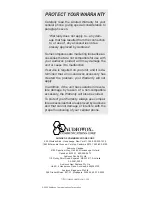
95
“PCS” phones. These types of wireless phones can expose
the user to measurable radiofrequency energy (RF) because
of the short distance between the phone and the user’s head.
These RF exposures are limited by Federal Communications
Commission safety guidelines that were developed with the
advice of FDA and other federal health and safety agencies.
When the phone is located at greater distances from the user,
the exposure to RF is drastically lower because a person’s RF
exposure decreases rapidly with increasing distance from the
source. The so-called “cordless phones,” which have a base
unit connected to the telephone wiring in a house, typically
operate at far lower power levels, and thus produce RF expo-
sures far below the FCC safety limits.
4. What are the results of the research done already?
The research done thus far has produced conflicting results,
and many studies have suffered from flaws in their research
methods. Animal experiments investigating the effects of
radiofrequency energy (RF) exposures characteristic of wire-
less phones have yielded conflicting results that often cannot
be repeated in other laboratories. A few animal studies, how-
ever, have suggested that low levels of RF could accelerate
the development of cancer in laboratory animals. However,
many of the studies that showed increased tumor develop-
ment used animals that had been genetically engineered or
treated with cancer-causing chemicals so as to be pre-dis-
posed to develop cancer in the absence of RF exposure. Other
studies exposed the animals to RF for up to 22 hours per day.
These conditions are not similar to the conditions under which
people use wireless phones, so we don’t know with certainty
what the results of such studies mean for human health.
Three large epidemiology studies have been published since
December 2000. Between them, the studies investigated any
possible association between the use of wireless phones and
primary brain cancer, glioma, meningioma, or acoustic neu-
roma, tumors of the brain or salivary gland, leukemia, or other
cancers. None of the studies demonstrated the existence of
any harmful health effects from wireless phone RF exposures.
However, none of the studies can answer questions about long-
term exposures, since the average period of phone use in these
studies was around three years.
5. What research is needed to decide whether RF expo-
sure from wireless phones poses a health risk?
A combination of laboratory studies and epidemiological stud-
ies of people actually using wireless phones would provide
some of the data that are needed. Lifetime animal exposure
studies could be completed in a few years. However, very large
numbers of animals would be needed to provide reliable proof
of a cancer promoting effect if one exists. Epidemiological stud-
ies can provide data that is directly applicable to human popu-
lations, but 10 or more years’ follow-up may be needed to pro-
vide answers about some health effects, such as cancer. This
is because the interval between the time of exposure to a can-
cer-causing agent and the time tumors develop - if they do -
may be many, many years. The interpretation of epidemiologi-
cal studies is hampered by difficulties in measuring actual RF
exposure during day-to-day use of wireless phones. Many fac-
tors affect this measurement, such as the angle at which the
phone is held, or which model of phone is used.
6. What is FDA doing to find out more about the possible
health effects of wireless phone RF?
FDA is working with the U.S. National Toxicology Program and
with groups of investigators around the world to ensure that
high priority animal studies are conducted to address impor-
tant questions about the effects of exposure to radiofrequency
energy (RF).
FDA has been a leading participant in the World Health Orga-
nization International Electromagnetic Fields (EMF) Project
Содержание 91155-GPX
Страница 107: ...107 ...













































